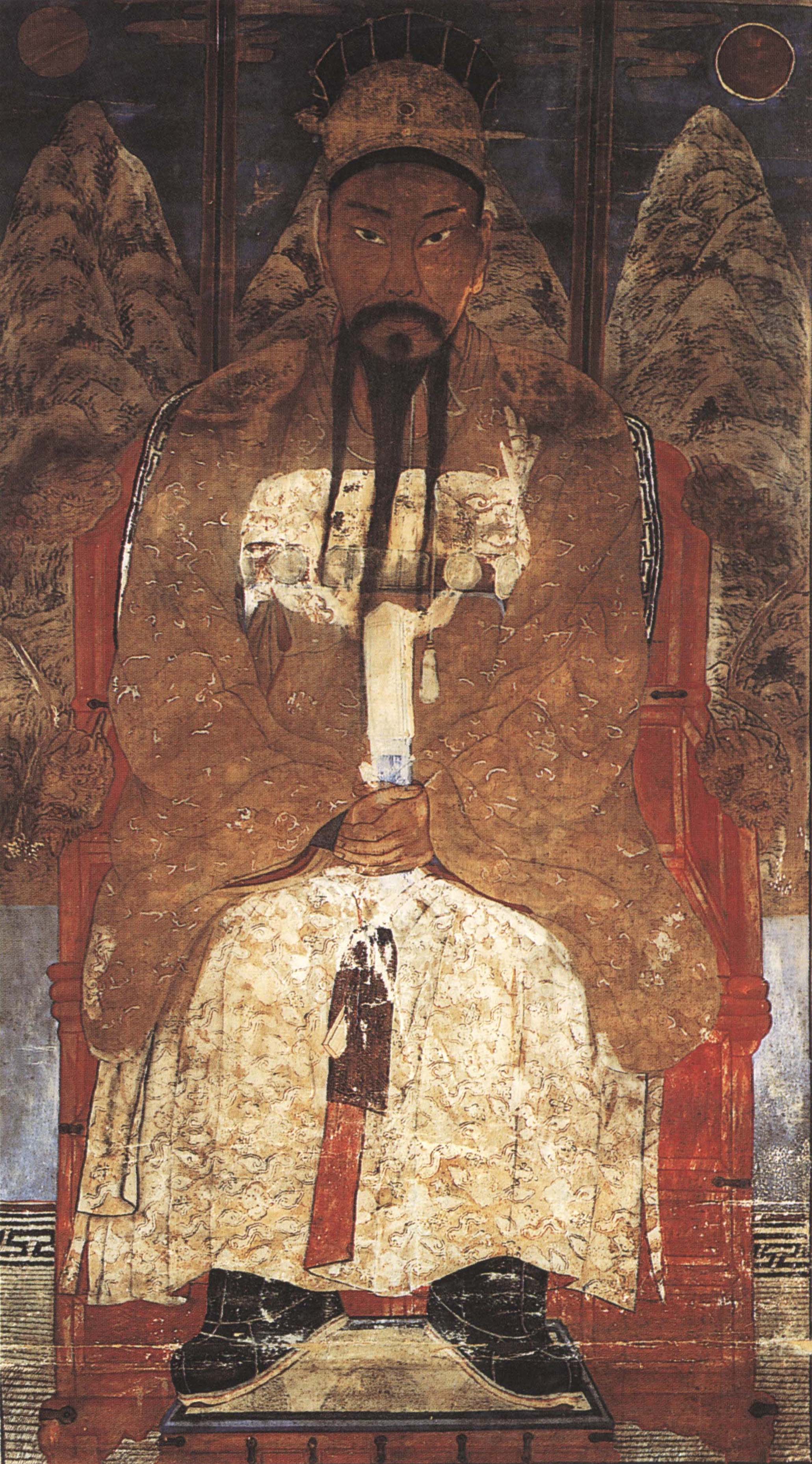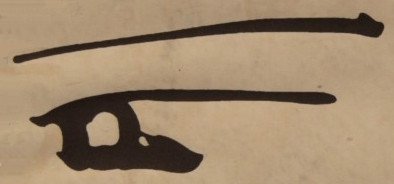|
Gongmin Of Goryeo
Gongmin (; 23 May 1330 – 27 October 1374), also known by his Mongolian name, Bayan Temür, was 31st ruler of Goryeo from 1351 to 1374. He was the second son of King Chungsuk. Biography Early life Goryeo had been a semi-autonomous vassal state under the overlordship of the Mongol Yuan dynasty since the Mongol invasions of Korea in the 13th century. Starting with King Chungnyeol, prospective rulers of Korea married Mongolian princesses and were customarily sent to the Yuan Court, in effect, as hostages. As per this custom, King Gongmin spent many years in the Yuan court, being sent there in 1341, before ascending the Korean throne. He married a Mongolian princess who became Queen Indeok. The Yuan dynasty began to crumble during the mid-14th century, and was eventually conquered and replaced by the Ming dynasty in 1368. Reign With the disintegration of Yuan, which had forcibly allied the Korean peninsula since the 40 year long Mongol invasion of Korea of 1238, King Gongm ... [...More Info...] [...Related Items...] OR: [Wikipedia] [Google] [Baidu] |
List Of Monarchs Of Korea
This is a list of monarchs of Korea, arranged by dynasty. Names are romanized according to the South Korean Revised Romanization of Korean. McCune–Reischauer romanizations may be found at the articles about the individual monarchs. Gojoseon Gojoseon (2333 BC – 108 BC) was the first Korean kingdom. According to legend, it was founded by Dangun in 2333 BC. Bronze Age archaeological evidence of Gojoseon culture is found in northern Korea and Liaoning. By the 9th to 4th century BC, various historical and archaeological evidence shows Gojoseon was a flourishing state and a self-declared kingdom. Both Dangun and Gija are believed to be mythological figures, but recent findings suggest and theorize that since Gojoseon was a kingdom with artifacts dating back to the 4th millennium BC, Dangun and Gija may have been royal or imperial titles used for the monarchs of Gojoseon, hence the use of Dangun for 1900 years. * : "An extreme manifestation of nationalism and the family cult was ... [...More Info...] [...Related Items...] OR: [Wikipedia] [Google] [Baidu] |
Mongolian Language
Mongolian is the Prestige (sociolinguistics), principal language of the Mongolic languages, Mongolic language family that originated in the Mongolian Plateau. It is spoken by ethnic Mongols and other closely related Mongolic peoples who are native to modern Mongolia and surrounding parts of East Asia, East, Central Asia, Central and North Asia. Mongolian is the official language of Mongolia and Inner Mongolia and a recognized language of Xinjiang and Qinghai. The number of speakers across all its dialects may be 5–6 million, including the vast majority of the residents of Mongolia and many of the Mongols in China, ethnic Mongol residents of the Inner Mongolia of China. In Mongolia, Khalkha Mongolian is predominant, and is currently written in both Cyrillic script, Cyrillic and the traditional Mongolian script. In Inner Mongolia, it is dialectally more diverse and written in the traditional Mongolian script. However, Mongols in both countries often use the Latin script for conve ... [...More Info...] [...Related Items...] OR: [Wikipedia] [Google] [Baidu] |
Liaoyang
Liaoyang ( zh, s=辽阳 , t=遼陽 , p=Liáoyáng) is a prefecture-level city of east-central Liaoning province, China, situated on the Taizi River. It is approximately one hour south of Shenyang, the provincial capital, by car. Liaoyang is home to Liaoning University's College of Foreign Studies and a number of vocational colleges. The city hosts a limited number of professional basketball and volleyball games in a modern sports facility. According to the latest statistics in 2020, the age distribution of the population in Liaoyang is as follows: 0–14 years old account for 9.83% of the population; 15–59 years old account for 62.26% of the population; 60 years old and above account for 27.91% of the population; 65 years old and above account for 19.46% of the population. History Liaoyang is one of the oldest continuously-inhabited cities in northeast China, dating back to before the Warring States period, and the site of the city has not changed ever since. Under the Yan ... [...More Info...] [...Related Items...] OR: [Wikipedia] [Google] [Baidu] |
Chi Yong-su
__NOTOC__ Chi may refer to: __NOTOC__ Greek *Chi (letter) (Χ or χ), the twenty-second letter of the Greek alphabet Chinese * ''Chi'' (length) (尺), a traditional unit of length, about ⅓ meter *Chi (mythology) (螭), a dragon *Chi (surname) (池, pinyin: ''chí'') * ''Ch'i'' or ''qi'' (氣), "energy force" *Chinese language (ISO 639-2 code "chi") *Ji (surname), various surnames written Chi in Wade–Giles Arts and entertainment * ''Chi'' (2013 film), a Canadian documentary film * ''Chi'' (2019 film), a Burmese drama film *'' Chi: On the Movements of the Earth'', a manga series by Uoto *''The Chi'', an American drama television series * Chi (''Chobits''), a character in the manga series ''Chobits'' *Sailor Chi, a character in the manga series ''Sailor Moon'' *Chi, a character in the manga series ''Chi's Sweet Home'' *"Chi", a song by Korn from the 1996 album ''Life Is Peachy'' Science and mathematics *Chi, the hyperbolic cosine integral *CHI (conference) for SIGCHI and its an ... [...More Info...] [...Related Items...] OR: [Wikipedia] [Google] [Baidu] |
Taejo Of Joseon
Taejo (; 4 November 1335 – 27 June 1408), personal name Yi Seong-gye (), later Yi Dan (), was the founder and first monarch of the Joseon dynasty of Korea. After overthrowing the Goryeo dynasty, he ascended to the throne in 1392 and abdicated six years later during a strife between his sons. He was honored as Emperor Go () following the establishment of the Korean Empire. Taejo emphasized continuity over change. No new institutions were created, and no massive purges occurred during his reign. His new dynasty was largely dominated by the same ruling families and officials that had served the previous regime. He re-established amicable ties with Japan and improved relations with Ming dynasty, Ming China. Biography Early life The future King Taejo was born in Ssangseong Prefecture on the frontiers of the Yuan dynasty. Taejo's father was Yi Cha-ch'un, an official of Korean ethnicity serving the Mongols, Mongol-led Yuan. His mother, Queen Uihye, Lady Ch'oe, came from a famil ... [...More Info...] [...Related Items...] OR: [Wikipedia] [Google] [Baidu] |
Yi Cha-ch'un
Yi Chach'un (; 20 January 1315 – 3 June 1361) or known by his Mongolian name Ulus Bukha (), was a minor military officer of the Yuan Empire who later transferred his allegiance to Goryeo and became the father of Yi Sŏng-gye, founder of the Joseon Dynasty. Biography Yi Chach'un was a chiliarch of a Yuan Dynasty mingghan in Ssangseong Prefecture (present-day Kŭmya County, South Hamgyŏng Province, North Korea - former Goryeo territory annexed by Mongol Empire). After Ssangseong was reconquered by Goryeo under King Gongmin, he migrated to Hamju and got promoted to manho (the equivalent of the Mongolian myriarch of a tümen, lit. ''ten thousand'' or chief of ten thousand). He married a Goryeo-Korean lady from Anbyeon, who became Queen Uihye, the mother of Yi Sŏng-gye. He died in Hamgyong in 1361. Since he was glamorized by his descendants, descriptions of Yi Chach'un's life tend to be contradictory to each other. For example, he is said to have risen to the rank of scholar- ... [...More Info...] [...Related Items...] OR: [Wikipedia] [Google] [Baidu] |
Ch'oe Yŏng
Ch'oe Yŏng (; 1316–1388), also romanized as Choi Young, was a Korean general born in Hongseong or Cheorwon during the Goryeo period. He became a national hero after he put down Cho Il-sin's Rebellion (). He also participated in the Red Turban Rebellions and later allied with the Ming dynasty to overthrow the Mongol Yuan dynasty. In his final years, General Ch'oe was betrayed and executed by his former subordinate Yi Sŏng-gye, who founded the Joseon dynasty of Korea, bringing an end to the Goryeo period. Early years Ch'oe Yŏng was born into the prestigious Cheorwon (more recently known as Dongju) Ch'oe noble clan as the fifth generation descendant of Ch'oe Yu-ch'ŏng, the Grand Scholar of Jiphyeonjeon, the Royal Academy, and the son of Ch'oe Wŏn-jik. He was raised in a strict austere lifestyle, befitting a noble aristocratic family of Goryeo. He paid little heed to what he wore and ate, and eschewed fine garments and other comforts even after becoming famous and succes ... [...More Info...] [...Related Items...] OR: [Wikipedia] [Google] [Baidu] |
Cho Il-sin
Cho Il-sin (; ? – November 12, 1352) was a Goryeo civil official. A close confidant of King Gongmin while the future king was a Yuan hostage in Dadu, Cho became an official of the Goryeo court after Gongmin's return to Goryeo and ascension to the Goryeo throne. His political rivalry with the influential pro-Yuan Ki family, the kin of Yuan Empress Ki culminated in the Cho Il-sin rebellion in 1352. Cho attempted to eliminate the Ki family but failed, and was executed by King Gongmin. Biography Given the childhood name of Cho Hŭng-mun, Cho was born into the Pyongyang Cho clan. He was the son of Cho Wi (), and the grandson of Cho In-gyu. His mother was Lady Na of the Naju Na clan. Cho would later marry the daughter of Hong T'ak () and changed his name from Hŭng-mun to Il-sin. In 1340, Cho went to the Yuan dynasty and would end up serving the future King Gongmin, when he was a royal hostage in the Yuan court. In 1351, King Gongmin ascended to the Goryeo throne after returning ... [...More Info...] [...Related Items...] OR: [Wikipedia] [Google] [Baidu] |
Korea
Korea is a peninsular region in East Asia consisting of the Korean Peninsula, Jeju Island, and smaller islands. Since the end of World War II in 1945, it has been politically Division of Korea, divided at or near the 38th parallel north, 38th parallel between North Korea (Democratic People's Republic of Korea; DPRK) and South Korea (Republic of Korea; ROK). Both countries proclaimed independence in 1948, and the two countries fought the Korean War from 1950 to 1953. The region is bordered by China to the north and Russia to the northeast, across the Yalu River, Amnok (Yalu) and Tumen River, Duman (Tumen) rivers, and is separated from Japan to the southeast by the Korea Strait. Known human habitation of the Korean peninsula dates to 40,000 BC. The kingdom of Gojoseon, which according to tradition was founded in 2333 BC, fell to the Han dynasty in 108 BC. It was followed by the Three Kingdoms of Korea, Three Kingdoms period, in which Korea was divided into Goguryeo, Baekje, a ... [...More Info...] [...Related Items...] OR: [Wikipedia] [Google] [Baidu] |
Chungnyeol Of Goryeo
Chungnyeol (3 April 1236 – 30 July 1308), personal name Wang Kŏ, was the 25th king of Korea's Goryeo dynasty from 1274 to 1308. He was the son of Wonjong, his predecessor on the throne. Chungnyeol was king during the Japan of Mongol Invasions, reluctantly aiding in the offensives. Biography King Chungnyeol was the first Goryeo ruler to be remembered by the title ''wang'' (王), meaning "king". Previous rulers had received temple names with the suffix ''jo'' (祖) or ''jong'' (宗), meaning "revered ancestor" and a title typically reserved for emperors. After Goryeo became a vassal of the Mongol-led Yuan dynasty, the Yuan emperor Kublai Khan perceived this practice as lowering his own power and ordered that the Goryeo rulers could not receive such names henceforth. King Chungnyeol, who became the Crown Prince Sim(諶) in 1260, proposed to marry a daughter of Kublai Khan in 1271, which Kublai Khan agreed. Since then, for more than 80 years, Goryeo kings married members of M ... [...More Info...] [...Related Items...] OR: [Wikipedia] [Google] [Baidu] |



